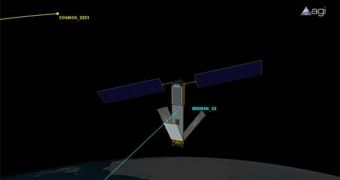As talk about setting up a global network for monitoring space debris ramps up, the United States Air Force is now forced to decide on whether to make even more data about its satellite system public.
Officials are still undecided about how they should proceed, given the sensitive nature of the information they are required to make available to international partners.
What is asked of the Air Force is to acknowledge the exact positions of all its satellites, and also that of orbital debris it keeps track of all by itself. But national security makes some of the data critical to the United States, and very sensitive for prying eyes.
The announcement was made by the deputy undersecretary for USAF space programs, Richard W. McKinney, on Monday, April 4. The official is also a member of the Senior Executive Service.
The recent talk about taking care of space junk in Earth's orbit was largely prompted by the collision of two satellites in 2009. An operational Iridium Communications satellite collided with a retired RosCosmos spacecraft, generating vast amounts of space debris.
This marked the first time two man-made objects collided in space. Its main consequence was that is spread vast amount of debris into orbits that are heavily circulated by numerous other spacecraft.
At the same time, the US military has a large number of sensors in space, which supply it with a variety of data on space junk. Some of these pieces of information are fed into a catalog of sorts. From this catalog, only a section called Two-Line Elements (TLE) is made public.
McKinney reminded that the USAF promised in 2009 to conduct a review on whether or not it should disclose more information to the public. According to the official, the process is still ongoing.
“We’re looking at that, and we’re looking at M2M relationships,” he said, referring to the automated, machine-to-machine system that currently governs the way sensitive data are now shared.
“A policy on how we would share data, and whether we go beyond TLE, is part of the review,” added the official at the MilSpace 2011 conference. The meeting was organized by SMi Group of London.
“There are some real security issues involved. But having said that, I can say we don’t want to see another collision in space, which would create yet more debris that no longer can be maneuvered,” he told attendants.
The announcement came as the US is getting ready to upgrade the Space Surveillance Network's (SSN) Space Fence. This is an array of Very High Frequency radars at various locations around the country, which keep an eye out for what's going on in Earth's orbit, Space reports.

 14 DAY TRIAL //
14 DAY TRIAL //